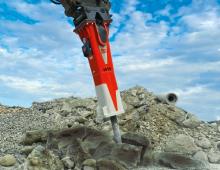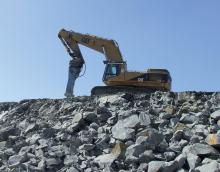
Use of a hydraulic breaker on the site of a Hyderabad road project is helping to cut aggregate transportation costs with material produced on site
Improving traffic flow is the main aim of the new 158km Hyderabad Outer Ring Road Project in India and material processing is also playing a part in reducing traffic to the construction site. Indian contractor
Alongside part of the length of the highway are considerable deposits of granite, and Ramky is quarrying this to use as aggregate for the Shamshabad and Gachibowl section of the highway. The company has a policy of reducing the cost of building materials through backward integration, so has in-house capabilities to produce materials such as mixed concrete, aggregates and asphalt.
According to the company, this also allows it to control the quality of the materials it uses and ensure timely delivery.
Controlled blasting is being used to excavate the rock, with small amounts of explosives being used to avoid possible cracking of buildings in nearby residential areas. The explosives are breaking the rock into fragments between 1.5 and 1.8m in size, the boulders then being trucked into the breaking area where the MB 1700 is working in a static position, mounted on an L&T
On Ramky’s section of the project, the MB 1700 is being used to break the rock, which is classified as hard granite with substantial quartz content, into pieces of between 500 and 600 mm. These are then loaded into dump trucks and conveyed to the site, where they are fed directly into the crushers, which are processing around 200tonnes per hour. Ramky started work on the project in 2009 and the company has said that use of onsite processing should ensure the November 2012 deadline for completion of the works should be met with no difficulties.









